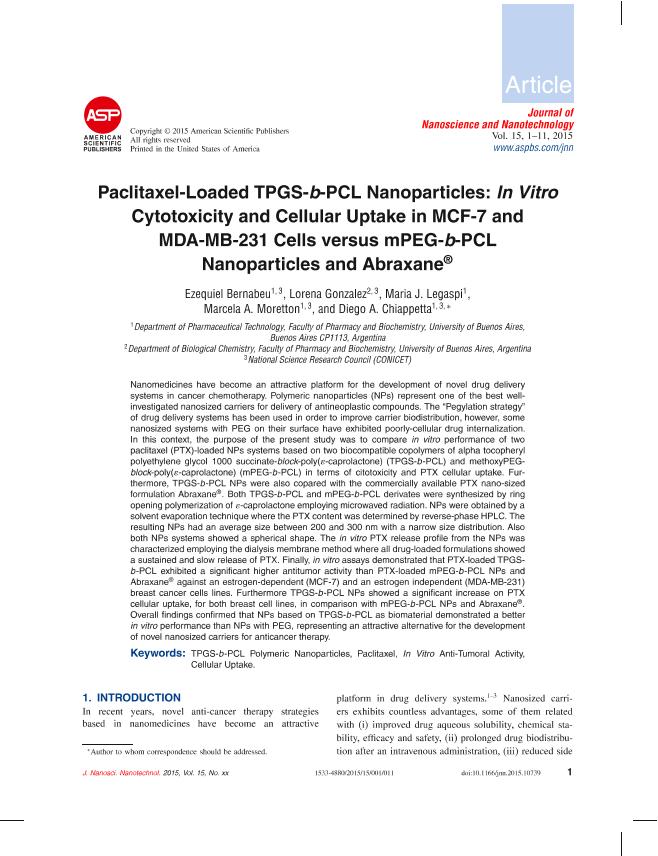Mostrar el registro sencillo del ítem
dc.contributor.author
Bernabeu, Ezequiel Adrian

dc.contributor.author
Gonzalez, Lorena

dc.contributor.author
Legaspi, M. J.
dc.contributor.author
Moretton, Marcela Analía

dc.contributor.author
Chiappetta, Diego Andrés

dc.date.available
2020-11-05T20:22:50Z
dc.date.issued
2015-02
dc.identifier.citation
Bernabeu, Ezequiel Adrian; Gonzalez, Lorena; Legaspi, M. J.; Moretton, Marcela Analía; Chiappetta, Diego Andrés; Paclitaxel-Loaded TPGS-b-PCL Nanoparticles: In Vitro Cytotoxicity and Cellular Uptake in MCF-7 and MDA-MB-231 Cells versus mPEG-b-PCL Nanoparticles and Abraxane®; American Scientific Publishers; Journal of Nanoscience and Nanotechnology; 16; 1; 2-2015; 160-170
dc.identifier.issn
1533-4880
dc.identifier.uri
http://hdl.handle.net/11336/117741
dc.description.abstract
Nanomedicines have become an attractive platform for the development of novel drug delivery systems in cancer chemotherapy. Polymeric nanoparticles (NPs) represent one of the best wellinvestigated nanosized carriers for delivery of antineoplastic compounds. The “Pegylation strategy” of drug delivery systems has been used in order to improve carrier biodistribution, however, some nanosized systems with PEG on their surface have exhibited poorly-cellular drug internalization. In this context, the purpose of the present study was to compare In Vitro performance of two paclitaxel (PTX)-loaded NPs systems based on two biocompatible copolymers of alpha tocopheryl polyethylene glycol 1000 succinate-block-poly(∈-caprolactone) (TPGS-b-PCL) and methoxyPEG-block-poly(∈-caprolactone) (mPEG-b-PCL) in terms of citotoxicity and PTX cellular uptake. Furthermore, TPGS-b-PCL NPs were also copared with the commercially available PTX nano-sized formulation Abraxane®. Both TPGS-b-PCL and mPEG-b-PCL derivates were synthesized by ring opening polymerization of ∈-caprolactone employing microwaved radiation. NPs were obtained by a solvent evaporation technique where the PTX content was determined by reverse-phase HPLC. The resulting NPs had an average size between 200 and 300 nm with a narrow size distribution. Also both NPs systems showed a spherical shape. The In Vitro PTX release profile from the NPs was characterized employing the dialysis membrane method where all drug-loaded formulations showed a sustained and slow release of PTX. Finally, In Vitro assays demonstrated that PTX-loaded TPGS-b-PCL exhibited a significant higher antitumor activity than PTX-loaded mPEG-b-PCL NPs and Abraxane® against an estrogen-dependent (MCF-7) and an estrogen independent (MDA-MB-231) breast cancer cells lines. Furthermore TPGS-b-PCL NPs showed a significant increase on PTX cellular uptake, for both breast cell lines, in comparison with mPEG-b-PCL NPs and Abraxane®. Overall findings confirmed that NPs based on TPGS-b-PCL as biomaterial demonstrated a better In Vitro performance than NPs with PEG, representing an attractive alternative for the development of novel nanosized carriers for anticancer therapy.
dc.format
application/pdf
dc.language.iso
eng
dc.publisher
American Scientific Publishers

dc.rights
info:eu-repo/semantics/openAccess
dc.rights.uri
https://creativecommons.org/licenses/by-nc-sa/2.5/ar/
dc.subject
PACLITAXEL
dc.subject
TPGS-B-PCL NANOPARTICLES
dc.subject
IN VITRO CYTOTOXICITY
dc.subject
CELLULAR UPTAKE
dc.subject.classification
Otras Nanotecnología

dc.subject.classification
Nanotecnología

dc.subject.classification
INGENIERÍAS Y TECNOLOGÍAS

dc.title
Paclitaxel-Loaded TPGS-b-PCL Nanoparticles: In Vitro Cytotoxicity and Cellular Uptake in MCF-7 and MDA-MB-231 Cells versus mPEG-b-PCL Nanoparticles and Abraxane®
dc.type
info:eu-repo/semantics/article
dc.type
info:ar-repo/semantics/artículo
dc.type
info:eu-repo/semantics/publishedVersion
dc.date.updated
2020-09-08T14:01:13Z
dc.journal.volume
16
dc.journal.number
1
dc.journal.pagination
160-170
dc.journal.pais
Estados Unidos

dc.journal.ciudad
California
dc.description.fil
Fil: Bernabeu, Ezequiel Adrian. Universidad de Buenos Aires. Facultad de Farmacia y Bioquímica. Departamento de Tecnología Farmacéutica; Argentina. Consejo Nacional de Investigaciones Científicas y Técnicas. Oficina de Coordinación Administrativa Houssay; Argentina
dc.description.fil
Fil: Gonzalez, Lorena. Consejo Nacional de Investigaciones Científicas y Técnicas. Oficina de Coordinación Administrativa Houssay; Argentina. Universidad de Buenos Aires. Facultad de Farmacia y Bioquímica. Departamento de Química Biológica; Argentina
dc.description.fil
Fil: Legaspi, M. J.. Universidad de Buenos Aires. Facultad de Farmacia y Bioquímica. Departamento de Tecnología Farmacéutica; Argentina
dc.description.fil
Fil: Moretton, Marcela Analía. Consejo Nacional de Investigaciones Científicas y Técnicas. Oficina de Coordinación Administrativa Houssay; Argentina. Universidad de Buenos Aires. Facultad de Farmacia y Bioquímica. Departamento de Tecnología Farmacéutica; Argentina
dc.description.fil
Fil: Chiappetta, Diego Andrés. Universidad de Buenos Aires. Facultad de Farmacia y Bioquímica. Departamento de Tecnología Farmacéutica; Argentina. Consejo Nacional de Investigaciones Científicas y Técnicas. Oficina de Coordinación Administrativa Houssay; Argentina
dc.journal.title
Journal of Nanoscience and Nanotechnology

dc.relation.alternativeid
info:eu-repo/semantics/altIdentifier/url/http://www.ingentaconnect.com/content/asp/jnn/2016/00000016/00000001/art00012?crawler=true&mimetype=application/pdf
dc.relation.alternativeid
info:eu-repo/semantics/altIdentifier/doi/http://dx.doi.org/10.1166/jnn.2015.10739
Archivos asociados
